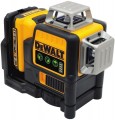Measurement range (with receiver)
The longest measurement range provided by a laser level (see “Type”) when using a special receiver with a photocell.
Thanks to its sensitivity, such a receiver is able to respond even to a weak laser beam, the mark from which is no longer visible to the naked eye; At the same time, the area of the photocell is quite large, and special indicators make it possible to determine the exact position of the mark. Among other things, this significantly expands the range of action of the level - the measurement range with a receiver is usually several times greater than without it. On the other hand, such equipment inevitably affects the overall cost of the device; and in some models the receiver
is not included in the package at all; it must be purchased separately. However, the second option also has its advantages: you do not need to immediately pay for an additional accessory, it can be purchased later, when a real need arises, while some models allow you to choose the optimal receiver model from several options at your discretion.
Note that the receiver can be useful not only for increasing range; These points are described in detail in paragraph “Included parts”.
Battery type
The model of a standard battery allows you to find out its characteristics in more detail, and also helps you understand what devices it is like and which one should be purchased in case of a replacement due to a malfunction or, if necessary, buy another similar one.
In box
—
holder. Devices for fixing the level / range finder on various surfaces. Such a device differs from a tripod primarily in its small size — within a couple of tens of centimeters. On the other hand, most holders allow you to install the device not only on horizontal, but also on vertical surfaces — for example, walls (and some are exclusively wall-mounted). Anyway, this function greatly expands the installation possibilities.
—
Receiver. laser radiation supplied with the device. This device is usually equipped with laser levels, less often with rangefinders, and it is not required at all for optical instruments. The main purpose of the receiver is situations where the laser mark is not visible to the naked eye — for example, at a long distance or in bright light. More details on the features of its application are described above in the paragraph “Measurement range (with receiver)”.
—
Tripod. Most modern instruments have a standard size thread and can be used with any suitable tripod. On the other hand, a complete tripod is most often specially designed for a certain model and optimally matches it in terms of general characteristics. In addition, this configuration option relieves you of the need to look for and purchase a suitable tripod yourself.
—
Case / case. The main function of these devices is to protect
...the device from bumps, scratches, dirt, temperature changes and other adverse effects; for this, of course, improvised means can also be used, but specialized protection is usually both more convenient and more reliable. In addition, almost all cases and most covers greatly simplify the transportation of the tool — in particular, due to the fact that they can also be used for complete accessories.
— Remote control. Among rangefinders and optical levels, this function is practically not found, because. working with them involves the constant stay of the device in the hands of the operator. But for laser levels that require you to regularly move from the device to the surface to be marked and back, the remote control can be a very useful addition — due to the fact that it minimizes such movements. For example, after marking the "front of work" on the wall according to the projection from the level, you do not have to approach the device to turn it off — just give a command from the remote control. At short distances, the savings in time and effort may not be so obvious, but over large areas, they can become quite noticeable.
